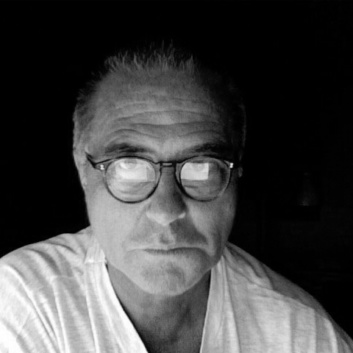
Eugenio was born in Bisceglie, a small town which was renown in Puglia to host one the very last madhouse of the country. As his best friends like to say, he would have quietly spent his entire life there if the house hadn’t been unwisely closed*.
Following an ineluctable family tradition, Eugenio graduates in Architecture: he works as an architect, and for some decades he divides himself between Bari and Monaco where strong feelings grown adding to those for his Enrica.
During all these years he cannot stop regretting he didn’t resist to the peremptory prohibition of devoting himself to art, because – everyone knows it – carmina non dant panem, poetry does not feed a man.
Nevertheless, as he retires, when putting food on the table is no longer his concern, he decides that the moment has come to do art.
He starts producing artworks that are immediately welcomed and thus galvanize him for his choice: they also improve his life quality, because creating art is a far freer activity than designing buildings.
But, let’s be straightforward: being a good architect is always an exciting job, but can you imagine how one feels creating for example “Spring with hole”?
G.L.* Until 1978 Bisceglie (Vescègghie – Vəʃɛ’ggjə) hosted one of the very last madhouses left in Italy. That’s why it is not unusual, in Puglia, that extravagant people with unconventional lifestyles are asked: “Where do you come from, Bisceglie?”
Precisely this desire to venture into the forest of forms seems to animate Eugenio Lopopolo’s Hybrids?, since their very own, uncertain definition, with the interrogative mark being a constitutive part of it: abstract compositions, on the limit between painting and sculpture, design and installation.
Goethe stated that doubt grows with knowledge. Beyond escaping any definitive meaning, the title Hybrids? stands for experimentation, for that limitless field where doubt and knowledge run incessantly after each other. One must indeed understand those Hybrids? as the crossroad of many impulses, experiences and attitudes that Eugenio Lopopolo has collected over time: for instance, they are the intersection between the artist-child’s freedom and the architect’s craft; the rigor of geometry and the gribouillage of the free hand; the knowledge of drawing as theory and its practice as a lighthearted game.
In some of Eugenio Lopopolo’s works, such a dance between opposites seems almost materialize in the recurring movement of their colorful lines, bursting from each direction inside the picture (Hybrid 2), thus subverting its traditional boundaries, and contributing to its identity of unusual, composite object, with a strong playful vocation. In their coloring as well as in their shapes, in their impressive size and in the use of the trompe l’oeil (Hybrid 6), eventually in their reference to Roy Lichtenstein’s pop aesthetics – that we easily recognize in the thick, black outlines (Hybrid 7), in the flat color fields and in a vague recall to the polka dots (Hybrid 3) – the Hybrids? do not only aim to raise questions in their observer.
Curiosity is always at once followed and nourished by an astonished and amused gaze, in a virtuous circle that constitutes the true aesthetic dimension of the Hybrids?: that encounter between knowledge and amusement, investigation and surprise, where art sprouts up lively, puzzling and suggestive.
Vittorio Parisi